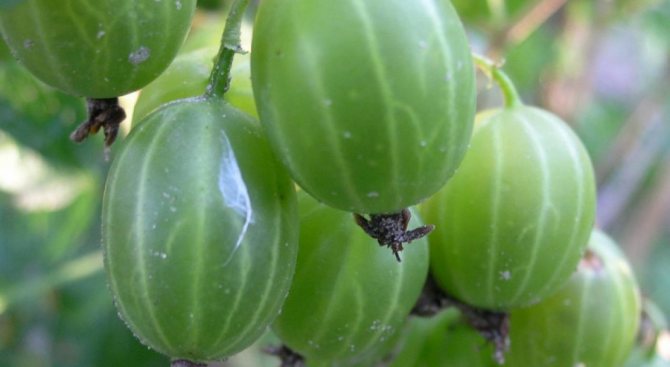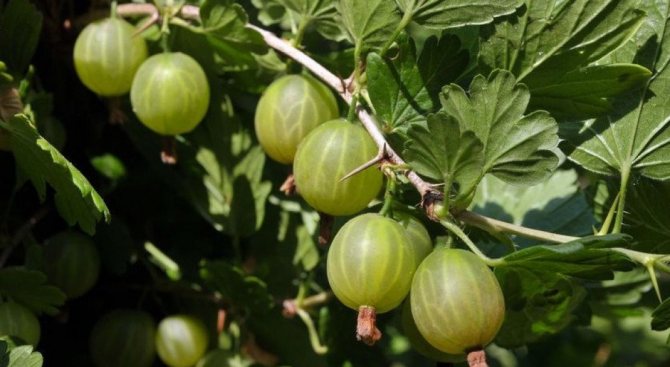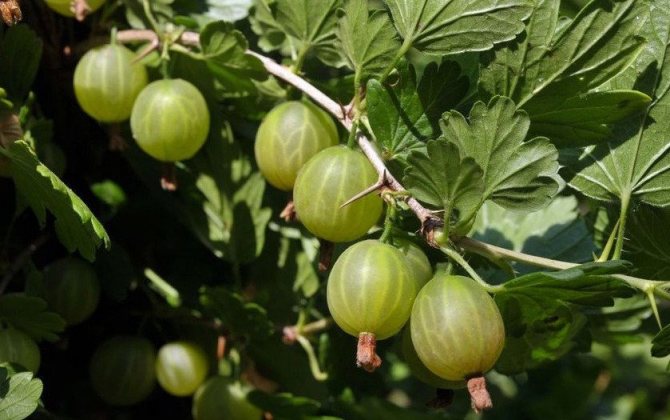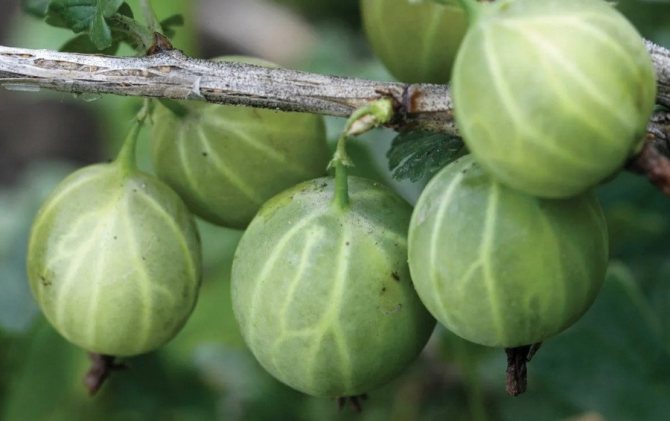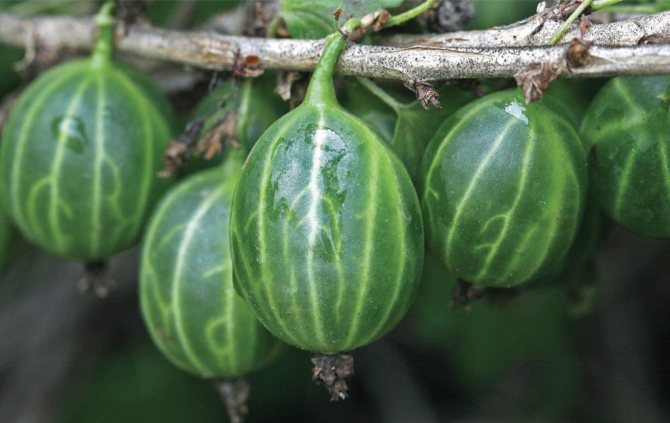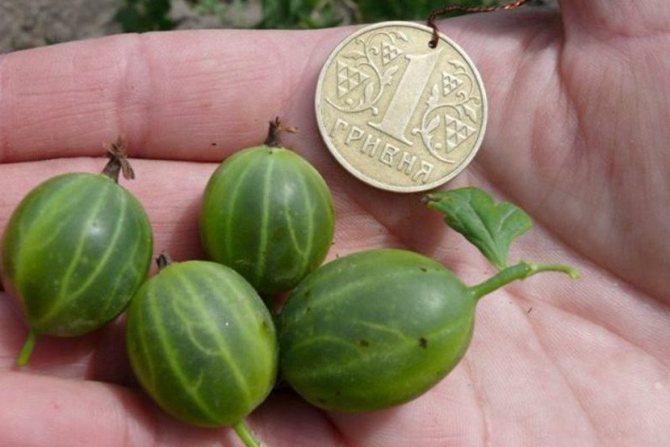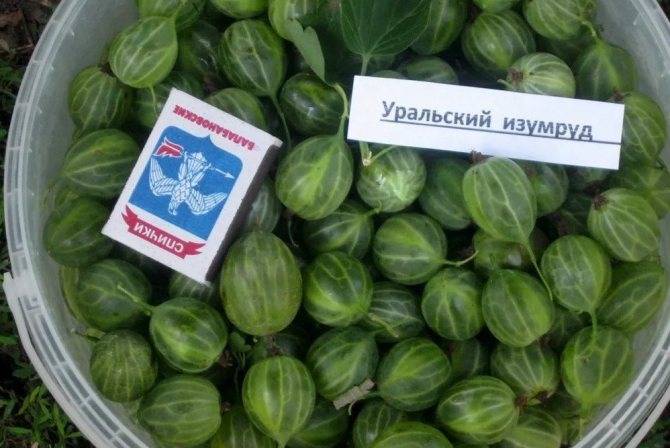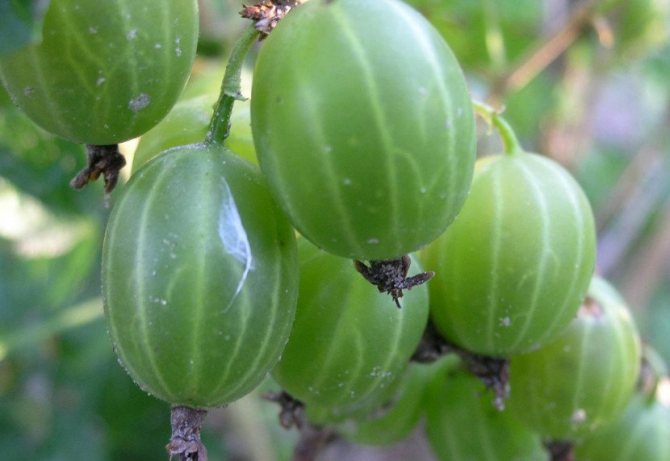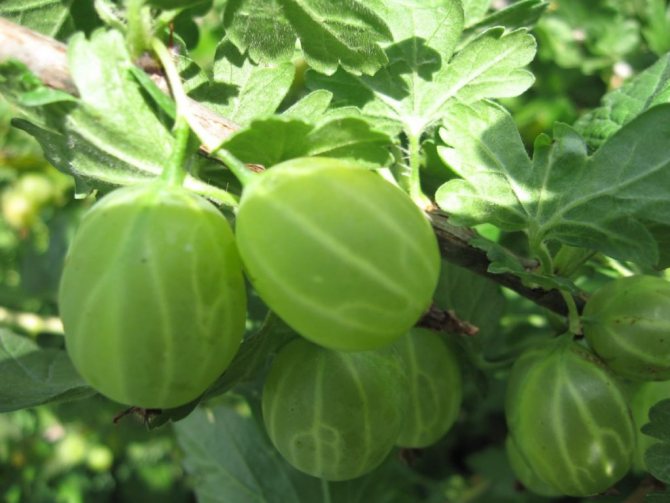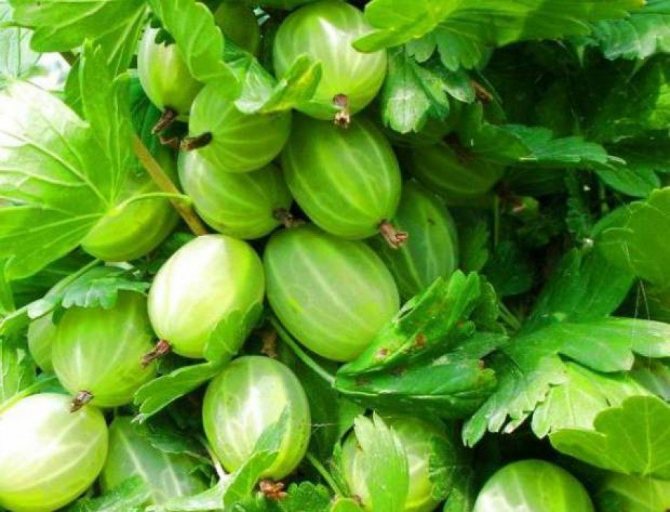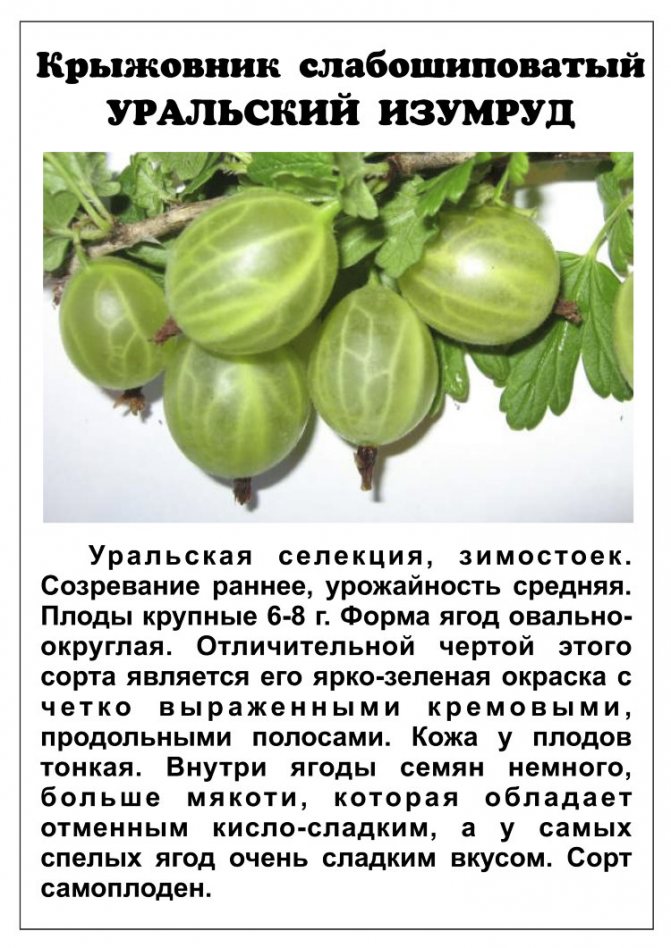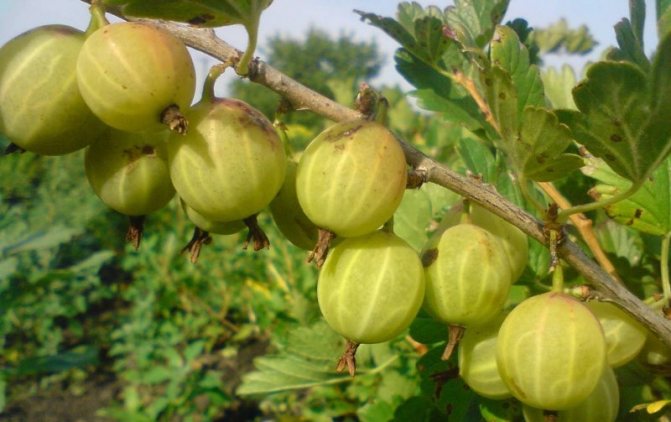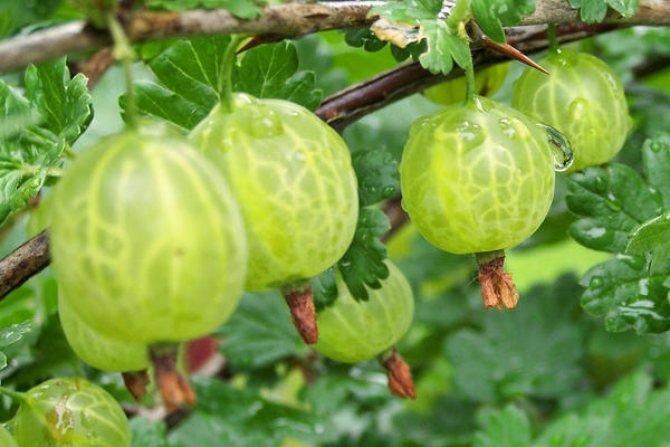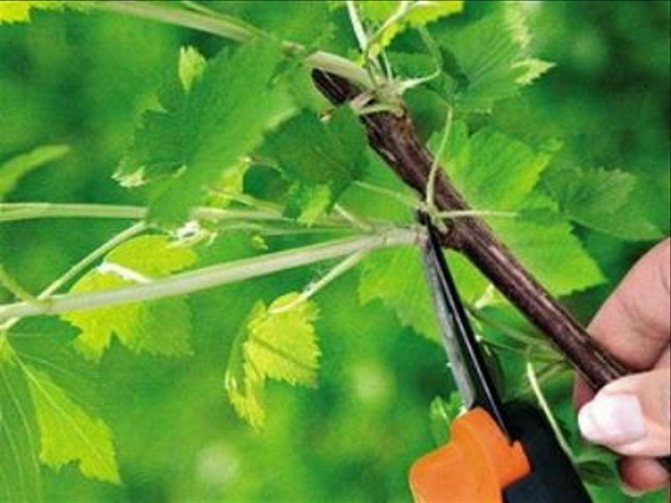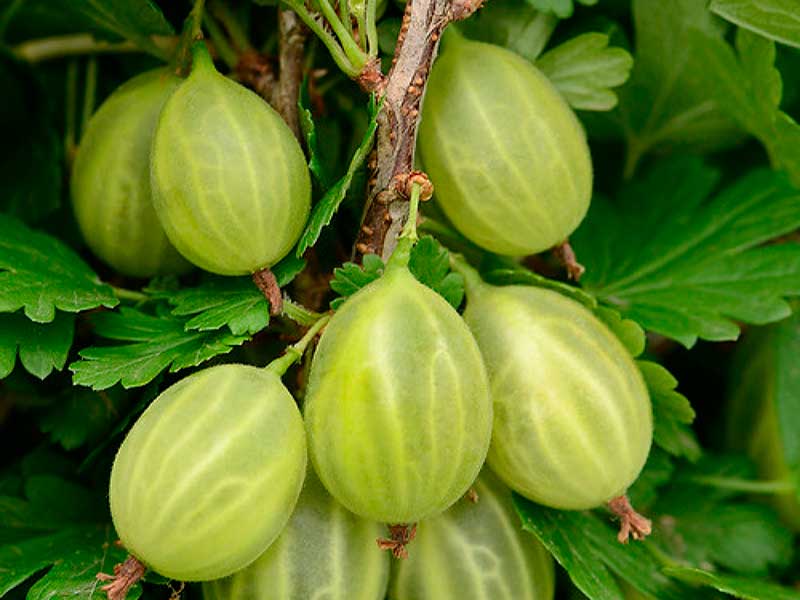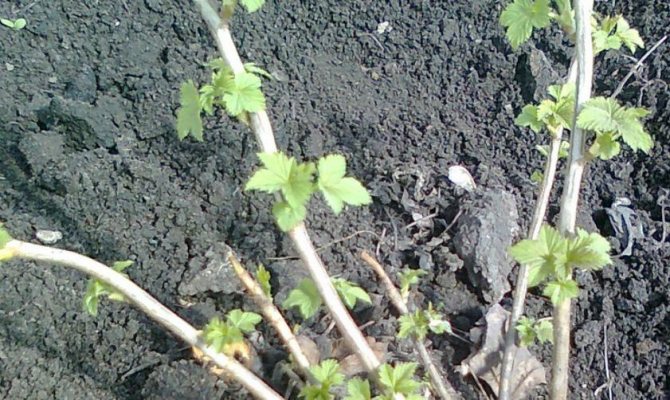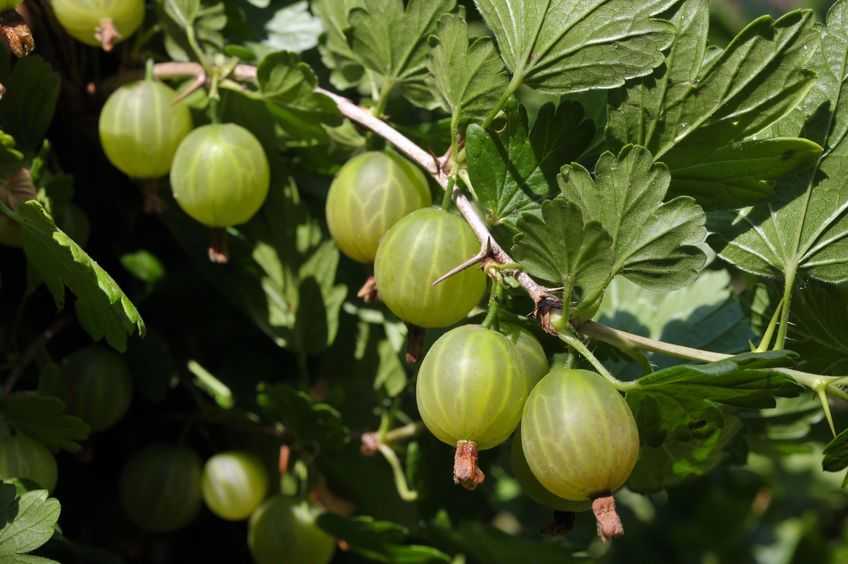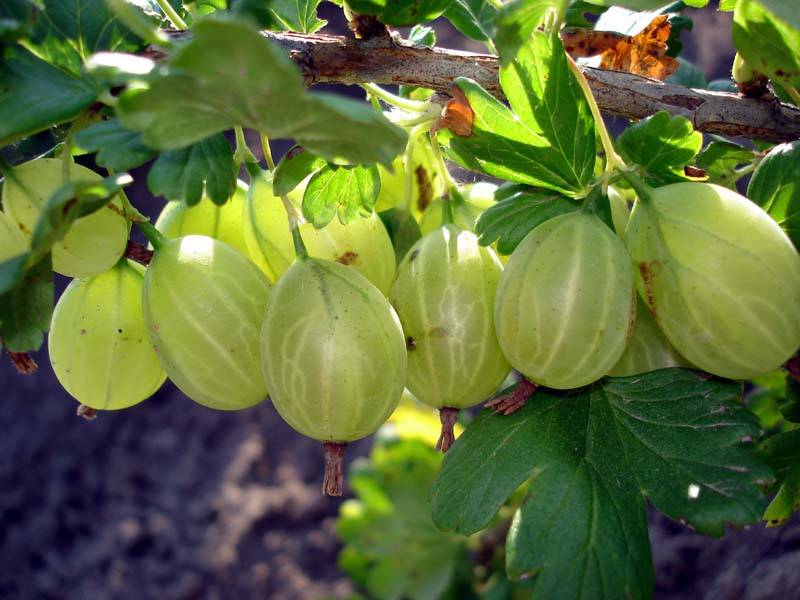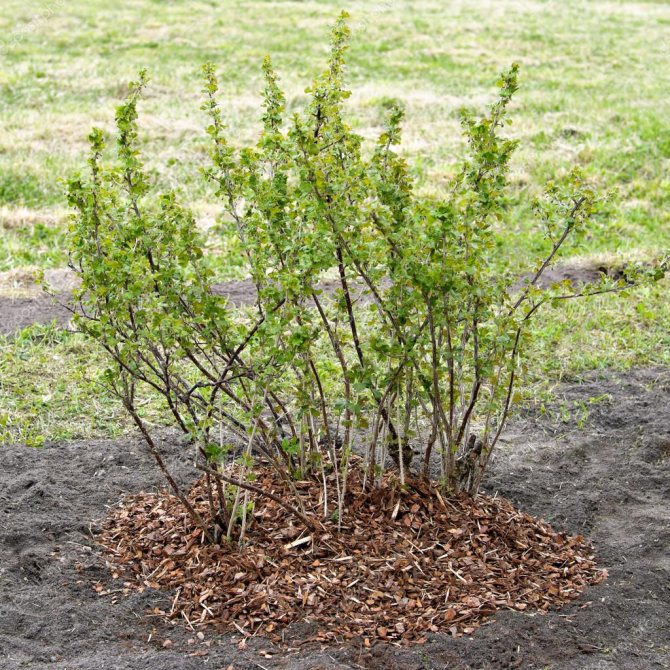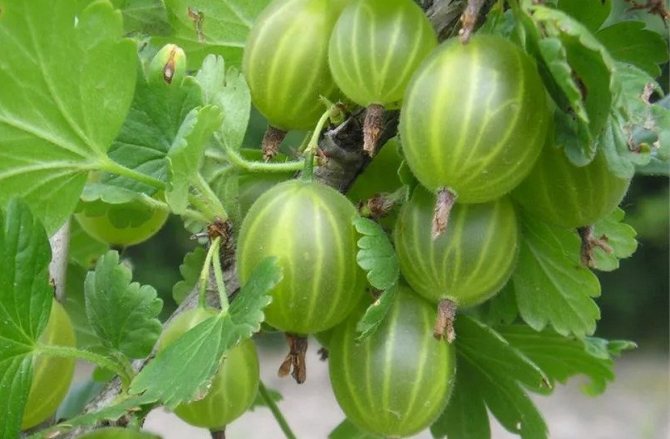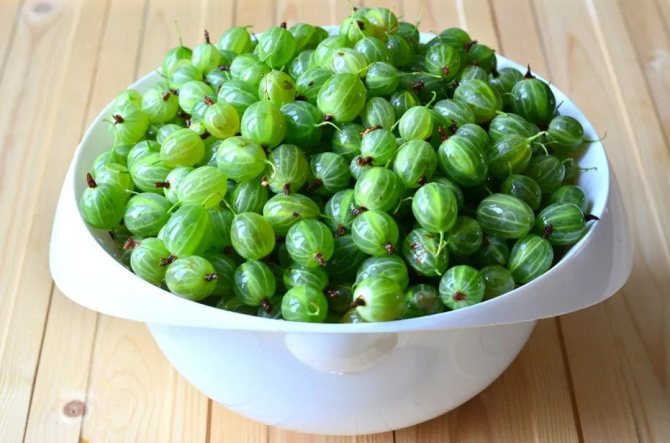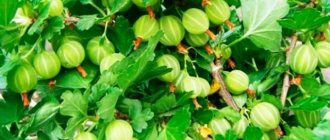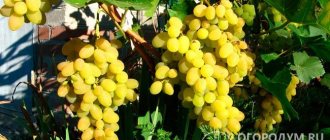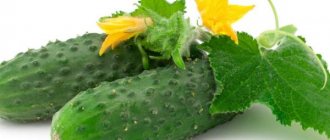When studying frost-resistant gooseberry varieties, the name Ural emerald is often found. This species is relatively new, but has already established itself in regions where ordinary varieties are not very comfortable. The novelty was added to the State Register of Breeding Achievements of Russia in 2000. The applicant is the Federal State Budgetary Scientific Institution "South Ural Research Institute of Horticulture and Potato Growing". Regions of admission - West Siberian (Novosibirsk, Tomsk, Kemerovo, Tyumen, Omsk regions, Altai Republic and Altai Territory) and East Siberian (Republics of Buryatia, Sakha, Khakassia, Tyva, Krasnoyarsk and Transbaikal Territories, Irkutsk Region). The variety is recognized as promising not only for amateur gardening, but also for industrial.
Breeding history of the variety
Gooseberry bushy "Emerald" ("Ural emerald") - the result of the selection work of the South Ural Research Institute in Chelyabinsk. V.S.Ilyin is considered the originator of the variety. The gooseberry was obtained from "Pervenets Minusinsk" and "Nugget". The "Ural Emerald" was created for cultivation in the West Siberian region. In 2000, the variety was entered in the State Register.
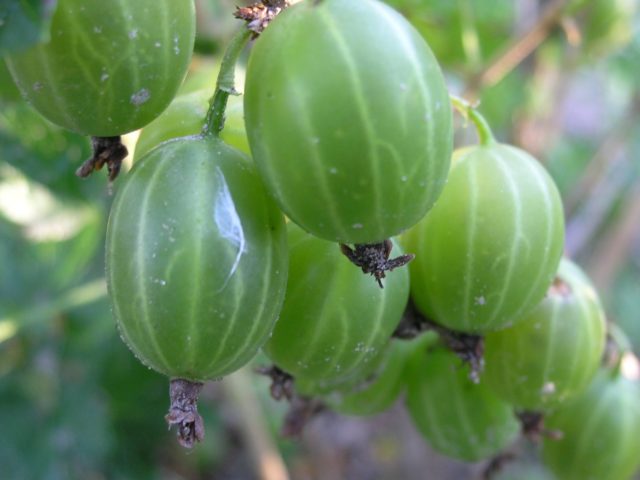
How to choose the right culture
Today, on the vegetable market of our country, you can buy almost any variety of gooseberries. But it is important to understand that each variety has its own characteristics of growth and is suitable only for a specific region. Therefore, when choosing the best varieties of gooseberries for the Urals, you should always take this point into account.
In general, it is not difficult to choose and purchase a crop suitable for the Ural climate if you contact a specialized nursery. To do this, you will need the following actions:
- choose a nursery located in your region, so you will be sure that the offered seedlings are zoned to your conditions;
- get winter-hardy crops;
- almost all modern hybrids are not only winter-hardy, but also resistant to many fungal defects, so give preference to these particular varieties;
- if you are a novice gardener, then choose those crops that do not require painstaking care and take root well.
At the moment, there are a lot of gooseberry varieties that do not have thorny thorns, and the berries have various rich colors and great taste. And in this case, the main thing is to choose the right variety.
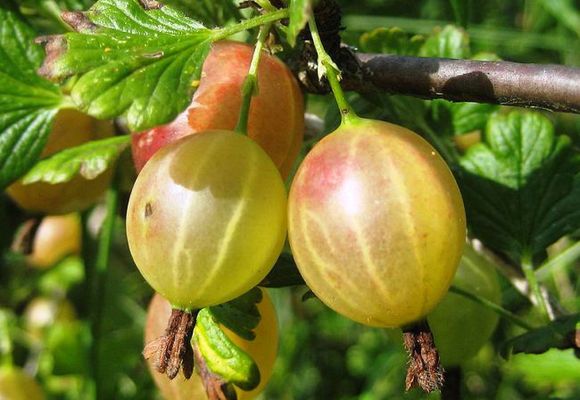

Description of the gooseberry variety Ural emerald
Characteristic features of a self-fertile early variety for universal use:
- The height of the Uralsky Emerald gooseberry is average up to 1.5 m, the bush is compact, not wide, but dense, and takes up little space on the site. Shoots are upright, stiff, perennial, light brown, green, thin annuals. The studding rate of the Emerald is low. The processes are soft, thornless. The gooseberry belongs to the thornless species.
- The leaf is dark green in color, the structure is uneven, five-lobed with wavy edges. Its sizes are uneven: small, medium, large. The crown is thick.
- Flowers are inconspicuous pinkish, medium-sized, single, bisexual. An ovary is formed on each of them.
Description of gooseberry fruit "Ural Emerald":
- on the bush, the fruits are not the same, the weight varies from 3.5 g to 7.5 g;
- rounded;
- the peel is transparent, does not hide a large number of seeds;
- the pulp of a thick yellow-green consistency, black seeds are small;
- the taste of the Uralsky Emerald variety is sweet with a slight sourness;
- the berry is juicy, aromatic.
"Emerald" was created for cultivation in Siberia and the Urals. Was adapted for harsh winters. Gradually, the gooseberry spread to the Central Black Earth part of the Russian Federation. Thornless gooseberry "Ural Emerald" can be found in the areas of the Stavropol and Krasnodar Territories.


Watering
During the season, gooseberries are watered several times. 1 bush requires 2 to 3 buckets.
The first time the gooseberry is watered is when the ovaries and new branches begin to form. The gooseberry is watered for the second time during the period of the beginning of fruit ripening.
In September, the last watering is done, which is aimed at building up the root system.
It is also worth noting that after each watering it is necessary to loosen the soil and clean the area of weeds.
Characteristics of the variety
Gooseberry variety "Izumrud" corresponds to the description declared by the originators in terms of yield and frost resistance. An unpretentious plant to care for, resistant to diseases and pests, has rightfully taken the place of a favorite.
Drought resistance, frost resistance
The Emerald gooseberry was created by crossing frost-resistant varieties, so the temperature drops of -35 ° C are not afraid of it. In more severe frosts, the culture without shelter may die. Variety "Emerald" is not drought-resistant - it requires constant watering for the entire growing season.
Advice! 10 days before picking berries, watering is stopped. If this condition is not met, the taste of the gooseberry will be sour.
Productivity and fruiting
The hybrid gooseberry "Ural Emerald", according to gardeners, is a high-yielding variety. Self-fertile by 40% - the amount of harvest will increase if other varieties are planted nearby, for example, "Beryl". He will act as a pollinator. "Emerald" produces berries with high gastronomic and biological characteristics. Ripens evenly by the end of June and mid-July. The yield from one bush is 4–5.5 kg, depending on the height of the berry crop.
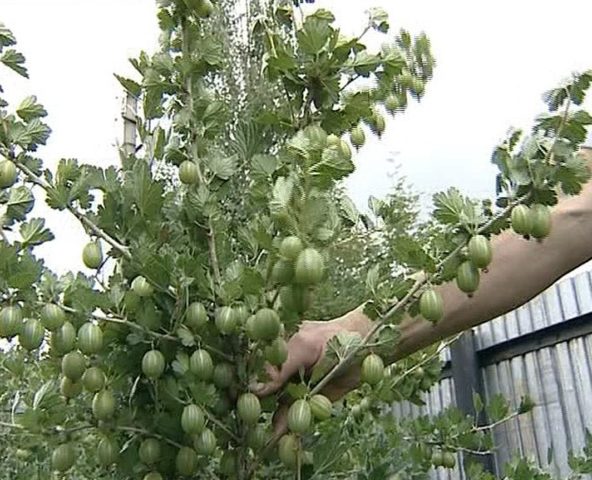

Gooseberries "Ural Emerald" are early ripening, so ripe berries are recommended to be removed immediately to prevent shedding. Fruits do not survive on the parent shrub after reaching maturity. In a hot summer without watering, the berries are prone to baking in the sun.
Scope of the fruit
The energy value of the crop is high; it is recommended to eat fresh gooseberries. Vitamins and trace elements are lost by 50% after heat treatment. Jams and preserves are made from berries, but they are liquid in consistency and a nondescript gray-green color. In addition to household plots, the Emerald gooseberry is grown on an industrial scale. With technical ripeness, the berry remains within 10 days, it tolerates transportation well.
Disease and pest resistance
Gooseberry "Emerald" is genetically resistant to damage by pests and fungal infections. If the rules of agricultural technology are not followed (a shaded place with nearby groundwater, irregular watering in a dry summer, violations of feeding norms), the variety is affected by a number of diseases: septoria, powdery mildew, anthracnose.
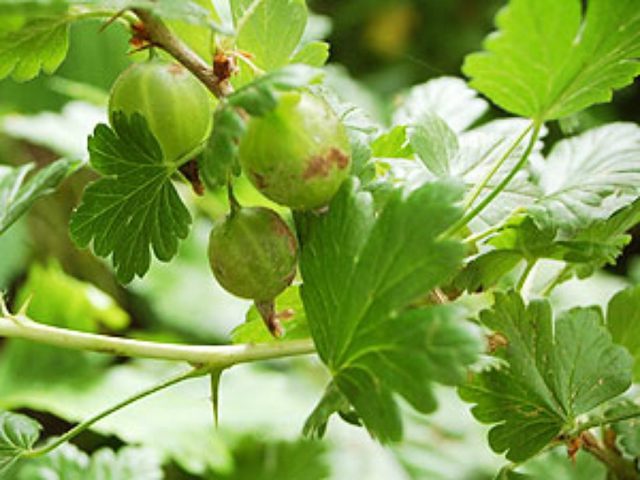

Pests parasitizing the culture: spider mites, aphids, goldfish.
Advantages and disadvantages of the variety
Gooseberry "Ural Emerald" meets all the declared characteristics:
- high frost resistance;
- abundant fruiting;
- adapted to the climate of the Urals and Siberia;
- fruiting times within 15 years;
- produces large berries with excellent gastronomic characteristics;
- disease resistant;
- "Emerald" bears fruit in all weather conditions;
- low studding;
- unpretentious gooseberry care;
- berries are stored for a long time without losing their taste;
- well transported over long distances.
The unstable amount of harvest can be attributed to the conditional disadvantage of "Emerald". If in one season the collection was up to 6 kg per plant, then the next summer may be half less. It also requires constant watering and too dense crown.
Gardeners reviews
Ksenia, 35 years old: “Protect your hands while picking berries. Maybe this variety has an average number of thorns, but they go along the entire branch, and the branches of the bush are thick. It seems that these thorns are just everywhere. But the fruits are very tasty, sweet, sugar. As if you really get emeralds with sweat and blood ”.
Sergey, 55 years old: “We have several bushes of this variety, for myself I consider it the most successful solution. Look: a) the variety tolerates the northern winter well; b) but his berries are "southern", that is, sweet, not sour; c) the harvest with normal care is very decent; d) care itself is completely simple, much easier than for many other winter-hardy varieties. So, comrades Siberians, I recommend this variety to everyone. "
Larisa, 48 years old: “An ideal gooseberry for a small plot. The bushes grow quietly close to each other, they tolerate a thin shade well, that is, a young tree nearby is also not a problem, but the harvest is excellent. I would also like to note the taste of the berries, they are very sweet. "
Gooseberry planting rules
Gooseberry "Ural Emerald" is not sprawling, compact. Placed on the site can be close to other varieties that will help pollinate the crop and improve the amount of harvest.
Recommended timing
The optimal time for planting the Emerald gooseberry is the end of September. You can breed a crop with a purchased seedling or prepare it yourself. If there is an adult "Emerald" bush, then one-year-old cuttings are added to it in early spring. Over the summer, they will give a root system, ready in the fall for placement in a permanent place.
Attention! When planting the variety "Uralsky Emerald" it is necessary to be guided by the specifics of the regional weather, so that before the onset of the first frost it is about two weeks - during this time the gooseberry will have time to take root.
Choosing the right place
The "Emerald" variety bears fruit well and does not get sick in areas open to the sun on the south side. In lowlands with close subsoil waters, the plant loses the quantity and quality of the crop, there is a risk of fungal infections. Gooseberry Ural Emerald "is not afraid of a sharp temperature drop, the north wind, but in shaded places it feels uncomfortable.
Variety "Emerald" demanding on the composition of the soil. For a good growing season, it is recommended to plant the plant in fertile loamy soil. Will not grow in a swampy place. If it is not possible to comply with the conditions, a seedling of the "Uralsky Emerald" variety is placed on an artificially prepared hill so that there is a distance of at least a meter to the subsoil waters.
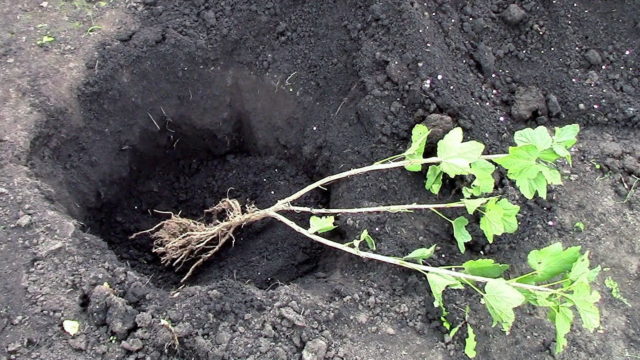

Selection and preparation of planting material
When choosing a cutting, attention is paid to the appearance of the plant:
- the presence of at least three shoots;
- they must be clipped;
- obligatory presence of intact kidneys;
- leaves are clean without spots;
- smooth bark of dark green color;
- the root system is developed, without dry processes.
Before planting, cuttings of the "Izumrudny" variety are placed in a manganese solution for 4 hours, then a growth stimulator "HB-101" is added to the solution.
Landing algorithm
Description of the sequence of planting gooseberry "Emerald":
- Prepare the place, dig up the soil, remove the weeds.
- Make a recess for planting with a diameter of 40 cm, a depth of 60 cm.
- At the bottom, 200 g of wood ash is poured.
- The roots are evenly distributed in the planting pit.
- Separate the shoots so that they do not touch.
- The planting material of "Emerald" is covered with soil.
- Water abundantly.


On the ground line, the buds are removed, taking into account that at least 4 pieces remain at the top of the cutting.
Reproduction
You can dilute gooseberries on the site with cuttings or layering.
By cuttings
The procedure is carried out after the flowering of the gooseberry. For this, 1-year-old shoots with a heel are cut off, planted in a container, and covered with foil. When the cuttings start to grow, the shelter is removed. The grown bushes are planted on the site.
Layers
Reproduction in this way is carried out as follows:
- digging grooves;
- bend the shoots in them;
- attach them with staples;
- watered;
- covered with earth.
When shoots appear from the layers, they are allowed to grow. Then they are separated from the mother plant, transplanted to a permanent place.


Gooseberry propagation by layering
Gooseberry follow-up care
Gooseberry "Ural Emerald" bears fruit within 15 years, in order to get the desired harvest every year it is recommended to take care of the plant:
- In the first 3 years in the spring, "Uralsky Emerald" must be fed with a fertilizer containing nitrogen.
- Form a bush immediately after planting by shortening 3-4 branches of the seedling to 5 buds. Next spring, 4 strong young shoots are added to the main crown, the rest are cut off. In the third year, according to the same scheme. In the end, you should get a bush with 10 branches forming a crown. Further formation, if necessary, is based on replacing old branches with young ones.
- The "Emerald" bush does not need a garter, the branches hold ripe berries well.
- Watering is carried out throughout the entire growth at least once every 7 days.
The variety "Uralsky Emerald" does not require shelter for the winter, it is enough to huddle and cover with straw or fallen leaves of fruit trees. The plant is not damaged by rodents.
Crown formation
The formation of the crown has 2 goals:
- Increased productivity.
- Prevention of neglect of the bush and reduction of natural aeration.
We also recommend reading: Description of the gooseberry variety Kolobok
Gooseberries tie berries well on branches that are no more than 7-8 years old. Further, the yield of such shoots falls rapidly. Ideally, you need to buy a new seedling and remove the old one. But usually, amateur gardeners, who only have gooseberries to decorate the garden and in order to eat a few berries, do not even think about digging up their favorite, fruiting bush. Therefore, you can resort to another method - the rejuvenation of the bush.
First of all, old branches are removed, which already give a smaller yield. From 8 to 20 branches are left on the bush. When the bush is 6-7 years old, then 2-3 old shoots need to be removed annually.
Diseases and pests, methods of control and prevention
The gooseberry variety "Uralsky Emerald" is practically not affected by diseases, it is not afraid of garden pests. In the rare case that dark spots appear on the leaves, and a gray bloom on the berries, "Emerald" is infected with a fungus that causes powdery mildew. To rid the Emerald gooseberry from the disease, it is recommended to treat the bush with Fitosporin, Oxykh or Topaz according to the instructions for the preparation.
As a preventive measure, watering the plant with hot water will destroy 70% of the spores before the appearance of buds. Then the Emerald gooseberry is sprayed with a 3% solution of Bordeaux liquid or soda ash (25 g per 5 l of water), wood ash is poured onto the root circle.
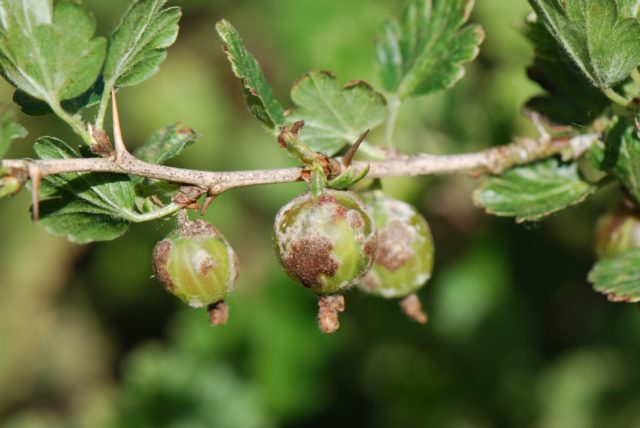

To combat parasites, special herbicides are used that are suitable for the type of pest.
Specificity of dressings
In the spring, nitrogen fertilizers are applied - rotted manure or urea.
During the period of flowering and ripening of berries, gooseberries of any variety need potash-phosphorus fertilizers. Ural Emerald may need additional nitrogen fertilization. The need for this arises if on all shoots under 3 years of age, the growth length is less than 20 cm.Nitrogen fertilizers during this period should be given very sparingly so as not to spoil the taste and quality of the berries.
In the fall, to increase the resistance of the bushes to low temperatures, you need to apply potash fertilizer. Usually 2-3 such dressings are made, dissolving from 20 to 100 grams of the substance in 10 liters of water. The fertilizer concentration is determined by the severity of winters in the growing region.
In the fall, nitrogen fertilization is meaningless, since the plant is dormant. But in the northern regions, where there are no thaws in winter, it can be laid in the fall. With the spring waters, the fertilizer will reach the roots just at the start of the growing season.
Growing
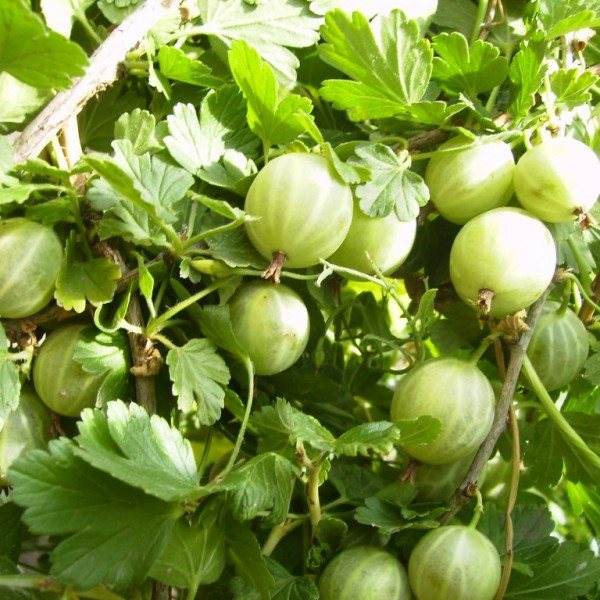

The Ural emerald gooseberry must be grown on fertile soils; loose loam is also suitable. Do not plant shrubs in low or high areas as the crop requires moderate moisture. The recommended groundwater depth is from 1 m.
It is better to purchase seedlings of the Ural emerald in specialized nurseries, where you can get advice on growing. As a rule, the bushes are sold in a container, that is, their roots are closed.
Important points:
- healthy appearance of the seedling;
- no signs of illness;
- the presence of 2-3 strong shoots with a length of 25 cm;
- lack of mechanical damage.
Plant in late September - early October, 3 weeks in advance. before the first frost. Until spring, the seedling will be able to take root, and with the onset of heat it will actively sprout. In the spring, in the summer, layering is done. They are bent down, fixed and covered with soil. In autumn, they take root, then they are separated from the main bush, then transplanted.
Site preparation
Free the selected area from previous plantings. Dig up the soil thoroughly, removing weeds, roots. It is recommended to simultaneously add humus (bucket for 1 m2), wood ash (liter jar for 1 m2). To increase soil fertility, it is good to use green manure (mustard, oats, lupine). They must be planted in the spring, mowed before flowering, and then dug up the ground.
For 2-3 weeks. before planting, make a hole 50x50 cm in size, about 0.5 m deep, separating the fertile layer. If you plan to plant several shrubs, the distance between the holes should be at least 1.5 m. On loam, use drainage (eg, crushed stone). Place it on the bottom, the layer thickness should be 10-15 cm.
Mix the fertile layer with fertilizers (humus or compost - 1.5-2 buckets, potassium sulfate - 40-50 g, superphosphate - 250 g). Place 2/3 of the mixture in the hole so that you get a mound, the top of which should be located slightly above the ground level. Now plant the gooseberries.
Step-by-step instruction:
- Place a seedling in the hole, spread the roots along the walls of the mound.
- Add the remaining potting mix, filling in the roots and compacting the soil. You need to deepen the gooseberry to the point of growth (the place where the shoots are connected to the roots).
- Shake the bush without lifting, then the earth will be compacted next to the roots.
- When about 9-10 cm remains to the top of the pit, carefully pour the gooseberries from the watering can, pouring out 2/3 of the water. Wait a little for it to be absorbed.
- Pour the remaining soil into the hole.
- Water the seedling with the rest of the water.
- After absorbing moisture, sprinkle the soil with peat, coarse sand or moss.
- Water the bush again after a few days.
If the gooseberries are in a container, spill the soil well. Remove the seedling along with the soil. Drop it into the hole, gently straighten the roots sticking out of the lump. Backfill with soil, then tamp gently. Water the bush, mulch the soil.

